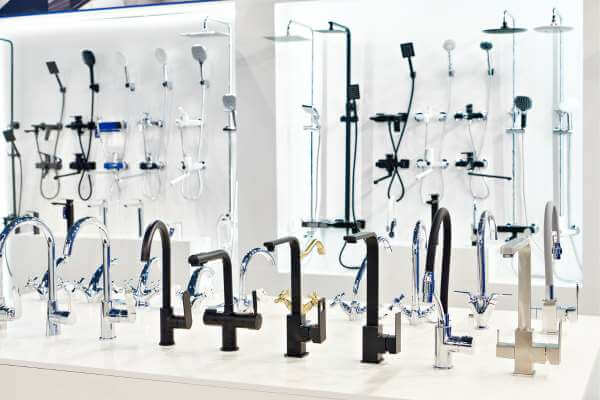Faucets are a vital part of our daily lives, and most of us use them without much thought. However, have you ever wondered how they control the temperature of the water coming out of them? In this article, we’ll delve into the various ways faucets can control temperature and the technology behind it.
How Do I Adjust the Temperature on My Kitchen Faucet?
Single-handle faucet
The most common type of faucet is the single-handle faucet, which typically controls both water volume and temperature. It has a single lever that rotates to either the left or right to adjust the temperature, and up or down to adjust the water volume. The mechanism behind this is a cartridge or ball valve that controls the flow of hot and cold water. The cartridge contains two discs with holes in them, one for hot water and the other for cold water. By turning the lever to the left or right, the discs move relative to each other, allowing more or less hot or cold water to mix and achieve the desired temperature.
Dual-handle faucet
Another type of faucet that can control temperature is the dual-handle faucet. This type of faucet has two handles, one for hot water and the other for cold water. By adjusting the handles independently, the user can achieve the desired temperature. The technology behind this type of faucet is similar to that of the single-handle faucet, with two separate cartridges controlling the flow of hot and cold water.
Touchless or motion-activated faucets
In recent years, touchless or motion-activated faucets have become increasingly popular. These faucets have sensors that detect the presence of a user’s hands and automatically turn on the water. They also have temperature control mechanisms that work in a similar fashion to the single-handle faucet. The user can adjust the temperature by waving their hand near the sensor to activate the lever or by using a manual override button.
Thermostatic faucets
Finally, thermostatic faucets are a less common but highly advanced type of faucet that control temperature using a thermostatic valve. This valve has a temperature-sensitive element that expands or contracts with changes in water temperature. As the water temperature changes, the valve adjusts the flow of hot and cold water to maintain a consistent temperature. These types of faucets are typically used in commercial settings, where precise temperature control is critical.
Do all faucets have temperature control?
Most faucets have temperature control, but there may be some exceptions. For example, some specialty faucets, such as those designed for outdoor use, may not have temperature control if they only provide cold water. Additionally, some very basic models may not have temperature control, particularly in regions where warm water is not needed or readily available. However, the vast majority of faucets used in homes, offices, and other settings do have some mechanism for adjusting the temperature of the water, whether it’s a simple single-handle design or a more advanced thermostatic valve system.
What temperature should hot water be in kitchen sink?
The temperature of hot water in the kitchen sink should be between 120°F to 140°F (49°C to 60°C). This temperature range is hot enough to kill most bacteria that can cause illness and is also hot enough to effectively clean dishes and other kitchen items. However, water that is too hot can also cause burns, especially in young children or older adults with sensitive skin. Therefore, it’s important to test the water temperature with a thermometer or by touch before using it and adjust the water heater accordingly to ensure the proper temperature is maintained. It’s also recommended to keep the water heater set at 120°F (49°C) to prevent scalding and conserve energy.
Why is my kitchen faucet water not hot enough?
If your kitchen faucet water is not hot enough, there could be several reasons why:
- Water Heater Temperature: Check the temperature setting on your water heater. If it’s set too low, the water won’t get hot enough. Make sure the temperature is set to at least 120°F (49°C).
- Sediment Buildup: Over time, sediment can build up in the water heater tank and cause it to lose efficiency, resulting in water not getting hot enough. Flushing the tank may help remove the sediment and restore hot water flow.
- Faulty Heating Element: If you have an electric water heater, a faulty heating element could be the cause of the problem. A heating element that’s burned out or not working correctly will not heat the water properly, resulting in lukewarm or cold water.
- Broken Thermostat: If you have a gas water heater, a broken thermostat could be the issue. The thermostat controls the temperature of the water and if it’s not functioning correctly, the water won’t get hot enough.
- Clogged Pipes: Clogged pipes can restrict the flow of hot water, resulting in lukewarm or cold water. Pipes can become clogged with sediment or other debris over time, which can impact the water temperature.
If you’re not comfortable diagnosing and fixing the problem yourself, it’s best to call a licensed plumber to help you identify the cause and make any necessary repairs.
Conclusion
In conclusion, faucets control temperature using a range of mechanisms, from simple cartridges and ball valves to advanced thermostatic valves. Regardless of the technology, faucets provide us with the convenience of clean and controlled water, making our daily lives more comfortable and hygienic.


 Hi, my name is Debra Klein and I love modern kitchen designs! As a product reviewer, it’s my mission to help homeowners choose the right modern kitchen accessories for their homes. I want to give them the best solution possible so they can make the best decision for their needs. Thanks for reading!
Hi, my name is Debra Klein and I love modern kitchen designs! As a product reviewer, it’s my mission to help homeowners choose the right modern kitchen accessories for their homes. I want to give them the best solution possible so they can make the best decision for their needs. Thanks for reading!




